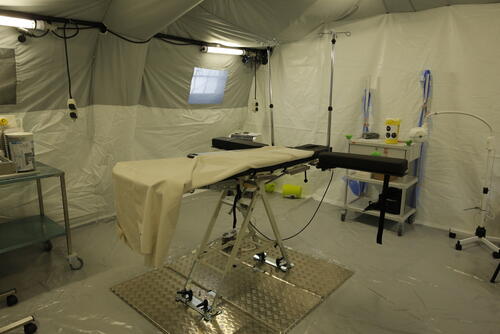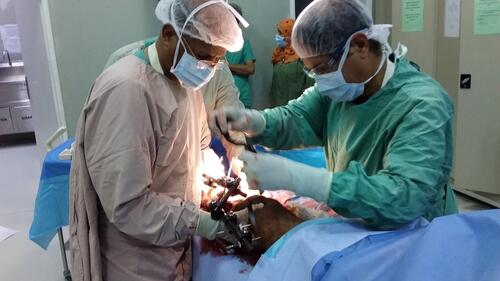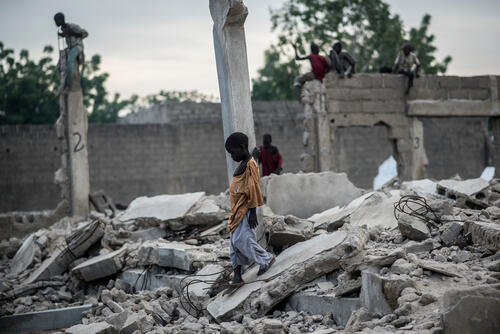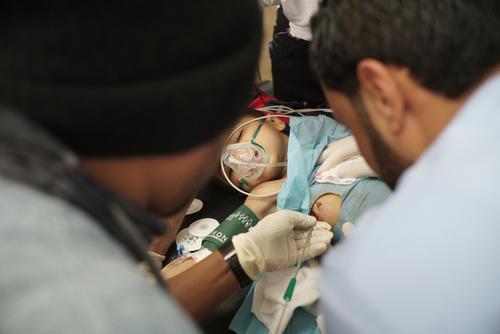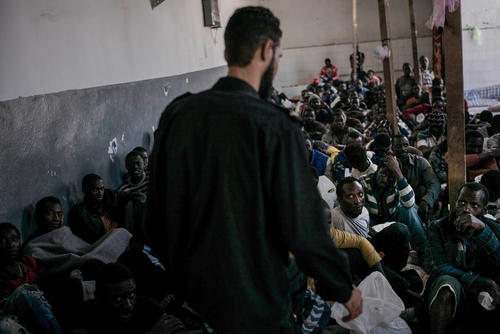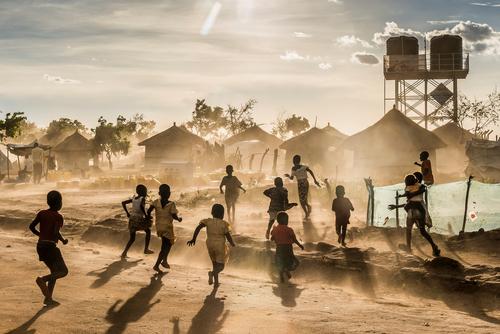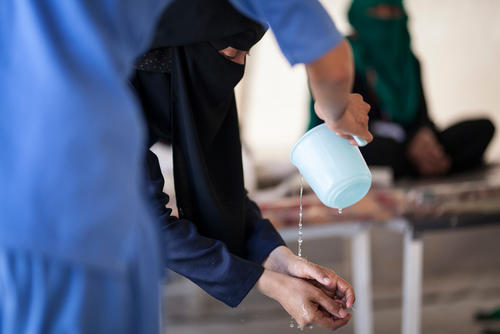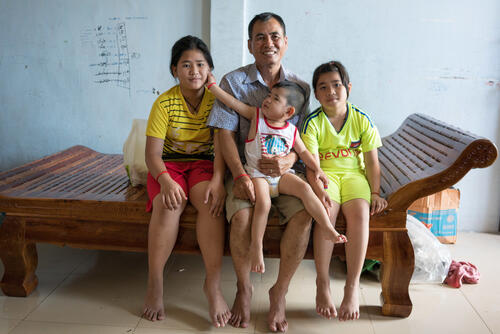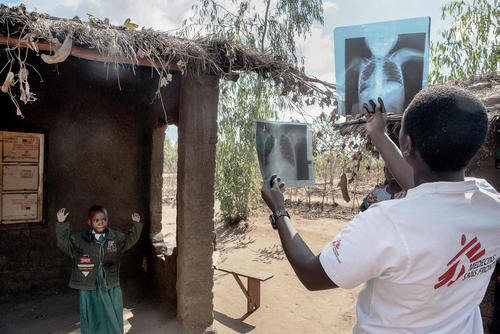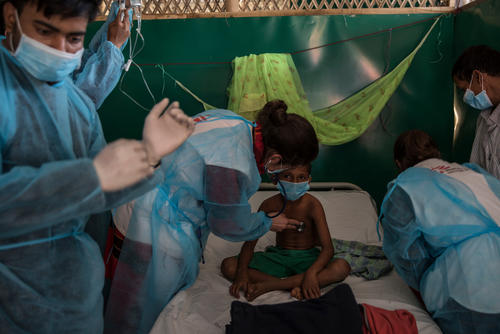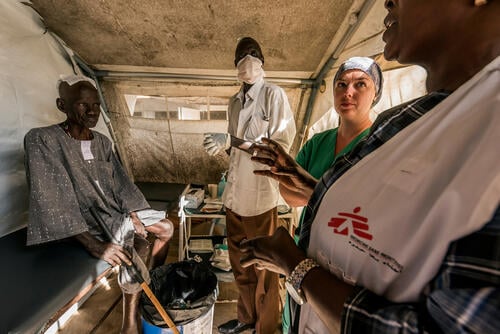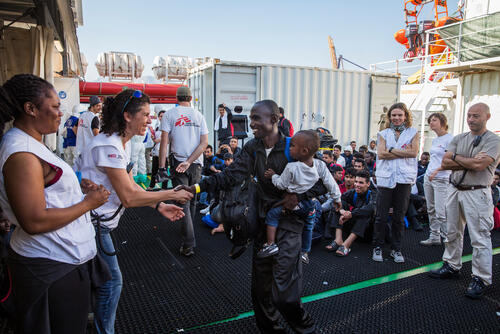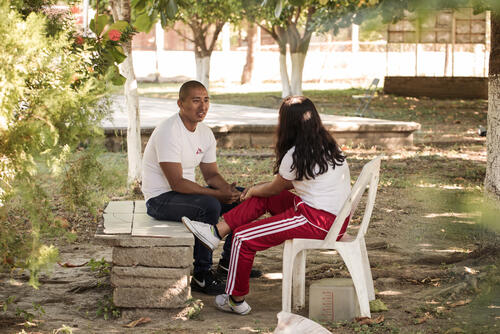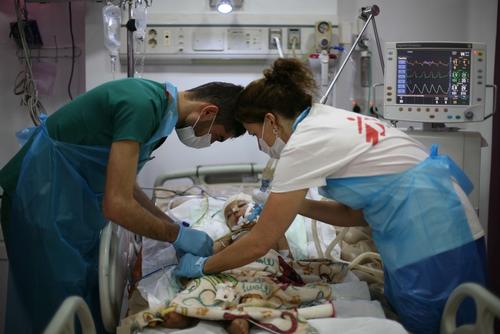For civilians in a conflict zone, bomb blasts don’t happen just to individuals, they happen to families and to communities. When we first started our trauma surgery project in Tal Abyad hospital in Syria, as a humanitarian response to the siege of Raqqa, one of our first patients was a girl of around 11 years old. Her family had been seeking shelter in a school when an improvised explosive device went off. None of her family was with her when she arrived at the hospital with severe burns. Fortunately, within 36 hours, her uncle and mother found her. Two other siblings had been injured in the explosion and were taken to other facilities, and we witnessed the powerful network of interconnected families and friends in this community who were able to eventually locate the two boys and reunite them with their sister in our hospital.
In the early days of the project, we saw both acute conflict-related wounds and older neglected injuries in patients who had access to surgical care for the first time in weeks. We also saw the typical surgical cases present in any community: road traffic accidents, broken bones from falls, appendicitis, etc. Once the fighting had finished, we had planned to scale down our surgical response, but people began moving back into Raqqa much faster than anticipated – and faster than the area could be properly cleared of explosive devices. What followed was an incredibly busy period as the hospital we supported was the only civilian trauma facility in the area and it became inundated with blast victims. This time, the injured were almost all young men who, venturing back alone to reclaim family homes and assess their land, faced the daunting task of avoiding the ordnance contaminating the area, often with tragic results. Here again the community experienced the devastating loss of working-age men and heads of families, just as they were trying to return home.
The MSF trauma response in the north of Syria – similar to that of our project in the south, and to others in Yemen and Iraq – focuses on the treatment of blast wounds and high-velocity projectile injuries, reflecting the sophistication and large military resources of the parties behind these conflicts. These interventions require technical expertise in resuscitation, critical care, care of burn wounds, and the treatment of complex abdominal, vascular and orthopaedic injuries.
Along with the technical aspects, there are numerous logistical challenges for trauma care in these contexts. Just getting patients from the point of injury to the hospital can be a hazardous endeavour with ongoing fighting, destroyed roadways and no true ambulance service. In places like Syria and Yemen, we try to set up trauma stabilisation points so that patients can receive first aid and emergency care, and be triaged and transported efficiently to a hospital where they can get lifesaving surgery. Fortunately, many of these countries have a history of good medical care, and the basic requirements for surgery, such as sterilisation, equipment and post-operative care, are all well known. Our highly skilled locally hired staff are critical in setting up and running these programmes.
The Middle East conflicts may be more in the public eye, but MSF also provides trauma surgery in the world’s forgotten wars. In South Sudan, which saw an increase in fighting in 2017, our response ranged from triage of mass-casualty events in smaller, more remote projects such as Lankien, to full surgical capacity in Bentiu. In places like South Sudan, the injuries are mostly from gunshots, knives, machetes or spears, reflecting the differences in the weapons of war in these contexts. However, although the injuries may be slightly less complex, the principles of trauma surgery remain the same: early and aggressive resuscitation, damage control surgery, and thorough and frequent cleaning of wounds. In Central African Republic (CAR), the situation can be so unpredictable that it can be a challenge to be in the right place at the right time with the right resources. In 2017 in CAR, we began supporting a new surgical programme in a Ministry of Health hospital in Bambari. But as the violence quickly escalated, we had to pull in resources, such as surgical staff and medical equipment, from MSF projects in other parts of the country to boost our response. We were also able to transfer patients to the trauma programme in Bangui for specialist care.
The countries enduring these forgotten wars have often suffered from a neglected medical system for decades. Setting up an emergency surgery programme in a remote area of South Sudan or CAR is very different to supporting an existing hospital in the Middle East. Often we have to bring in all the equipment, medications, biomedical devices and sometimes even a tent in which to operate – albeit a very sophisticated and sterile one! In these areas, a single surgical team may be expected to perform everything from the treatment of machete wounds to appendectomies to caesarean sections.
Everywhere we work, our locally hired staff are a huge asset in expanding our ability to provide surgical care. In the Democratic Republic of Congo, we have collaborated successfully for many years with the Ministry of Health in Mweso. In this project, trained and dedicated Congolese doctors provide the bulk of surgical care, while our staff from other countries offer coaching, teaching and supervision. In places like Mweso and Walikale in North Kivu, MSF forms part of the community, not just in the hospital but in the towns, with children often greeting you with shouts of “MSF” and a big thumbs-up sign as you walk to work.
Because the effects of violence ripple through communities, it takes a community response to treat the effects of trauma. Our trauma surgery community consists not just of the surgeons, doctors, anaesthetists and nurses who work directly on injured patients, but also the wider team of mental health workers, physiotherapists, logisticians and administrators. Not forgetting the interpreters, who provide not just language translation, but a deeper understanding of the places in which we work. As trauma surgeons and humanitarians, we are always striving to take the best care of our patients possible, whether it is in countries like Syria, which receive a lot of attention, or like CAR, which suffer largely outside of the public consciousness. In all of these places, we see the effect of violence on families and communities, we feel it with our patients and our colleagues, and we seek to make it better.



